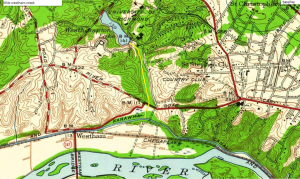Possibly the thing I found most surprising about our walk during class on Wednesday was that the University of Richmond campus makes up only about 15% of the Little Westham Creek watershed. Little Westham Creek is seemingly so small; I had a hard time believing it went on much past our school. However, the creek provides a significant connection between Westhampton Lake and neighboring bodies of water such as the James River and East Branch Tuckahoe Creek. Even this small body is important as a watershed, as bodies of water can have watersheds that are much, much larger than the bodies themselves. It’s all a matter of where the rain runs to. These watersheds connect chunks of land that are seemingly unconnected.
There is always the talk of the “Richmond Promise” that the University of Richmond has made, and part of that promise is how we pledge to be connected to the greater Richmond area. I always thought this pledge was just sort of something we said to put on a good appearance, but never really acted on, as students don’t even leave campus much. However, it was interesting to hear about how the University actually works with the local communities to prevent heavy river flow in our watershed. The university constructs LEED buildings and works on its sustainability, while the communities make rain barrels and rain gardens. Working for the school’s sustainability department, I always knew about our efforts, but now I see them as a part of how we interact with the community as a whole. Together we work make a better watershed. Before that walk I also only thought of the one directional interaction: University of Richmond community getting involved in the surrounding Richmond community. However, as we work together to improve the watershed, the community is more getting involved with us, as we contain only a small part of the Little Westham watershed, but yet the biggest benefit of the creek: Westhampton Lake.
I’ve edited this map so Little Westham Creek is in yellow. Surrounded by multiple important roads, the University of Richmond Campus, a county club, and other bodies of water, the creek runs past very different areas. While the population at the U of R is young, our neighbors at the country club tend to be much older. In our surrounding neighborhoods there are people of all ages living, working, and going to school. The water links us all and makes these spatial and demographic boundaries irrelevant. Even a small thing like a creek can create a cohesive community out of a large area.


Each time I walk by the Westhampton Lake on my way to class or dinner, I am always amazed to see the natural beauty that resides on our campus. Humans have always had a connection with nature. Recently, I have noticed more and more people having close to no link to the natural world around them. I believe that technology has pulled us further from the world that is currently around us and that most people have lost their sense of direction and place. Many people that attend U of R walk around this lake every day and have no connection to it what so ever. Several of your friends have commented about how dirty the lake is and it often makes me wonder if they have ever taken an environmental science class or a geography class ever in their life. My guess would be no, because if they had they would realize that the poor water quality can be directly linked to everyday actions of humans around the lake.
During class on Wednesday, we walked around the lake and talked about the different inputs into the lake. Many people do not know that there are two inputs into the Westhampton Lake. Another unknown for people is that a lot of the water that comes into the lake is from run off from impervious surfaces. This means the humans are directly changing the health of the water before it runs off the land. The take away message from observing the lake would be that every little action affects something bigger. In the case of the Westhampton Lake, if we clean up water here it will run into the James River. This cleaner input into the James will eventually help the overall health of the Chesapeake Bay. The same could be said if we pollute our small lake, not only will it be dirty on our campus, but we will be doing no favors for the Chesapeake Bay. This is why the University of Richmond is taking huge steps to improve the water quality of our lake. These changes will impact the water quality further down the line.
It is amazing the disconnect between students actions and their opinions on our lake. They criticize it for being dirty, but do not assume responsibility or think their actions make any difference. It is the same on every scale of our watersheds, from Little Westham to the Chesapeake Bay.
The changes have to come to the minds of the students and residents before there can be any support for real action. These changes happen slowly, but they can happen. Every one person working to improve their watershed positively influences others to do the same with their watershed. Eventually, we could connect everyone like this